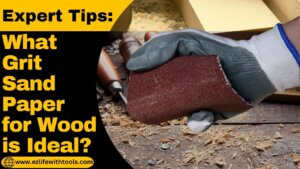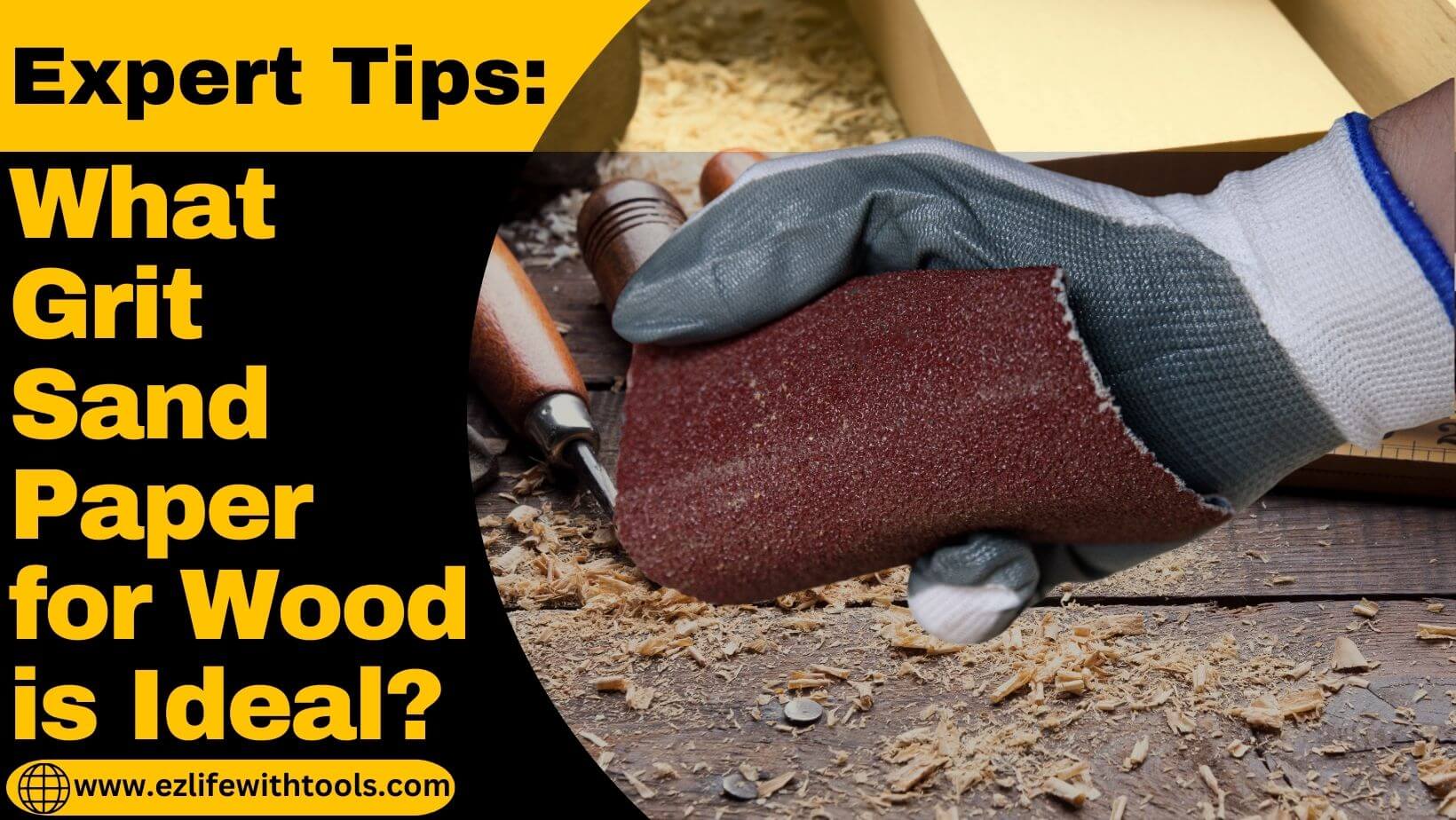Expert Tips: What Grit Sandpaper for Wood is Ideal to Use?

Sandpaper is an essential tool in woodworking, but choosing the right grit sandpaper is necessary according to the need of the project type for refinishing a piece of furniture or a new masterpiece.
Because a wide range of sandpapers are available in the market.
But don’t worry.
In this article, I will explain the types of grit numbers of sandpapers, the selection process, benefits and what grit sandpaper for wood is ideal to use.
So, keep reading.
Why Does the Right Grit Selection Matter?
Choosing the right grit sandpaper is necessary because using the wrong sandpaper can cause many difficulties, like uneven surfaces, poor finishing, and excessive material removal. Meanwhile, the right grit sandpaper ensures your project’s quality finishing and professional look.
Here are some highlighted vital reasons to use the right sandpaper.
- Right grit sandpaper helps to work efficiently.
- Coarse grit sandpaper helps to work speedily.
- Fine-grit sandpaper helps to create a smoother surface.
- Right grit sandpaper minimizes the chances of over-sanding of material.
- It can affect the durability of our project.
- Choosing the right grit sandpaper from the start of the project saves time.
What Grit Sandpaper for Wood is Ideal to Use?
Understanding Grit Levels
Sandpaper has different grit levels represented by the numbers, and we can identify the coarseness or fineness of abrasive materials on sandpaper and how aggressively it will remove the material. Let’s break it down into different grit numbers for better understanding.
1- Coarse Grits (40-80)
Its grit range starts from 40 to 80, which is the most aggressive. Coarse grit sandpapers are designed to quickly remove a significant amount of material, like stripping paint, removing heavy varnish, or levelling uneven surfaces.
Note: Coarse grit sandpaper can leave many visible scratches on the wood. So, after using it, use finer grit sandpaper to achieve a smooth surface.
2- Medium Grits (100-150)
Its grit range starts from 100 to 150, which is used to balance between material removal and surface finish like shaping wood, preparing it for painting, and removing scratches left by coarse grits.
3- Fine Grits (180-220)
Its range is 180 to 220, which is best for finishing touches. It is used to remove minor imperfections on the surface.
4- Very Fine Grits (320-600)
Its range starts from 320-600. It is used to achieve exceptionally smooth surfaces, especially projects like polishing between coats of paint or varnish.
5- Extra Fine Grits (800+)
Its range starts from 800 and goes on. It is used for most delicate tasks. This type of sandpaper can give a mirror-like shine to woodworking projects.
Different Types of Sandpaper
In addition to the grit level, various types of sandpaper are available, each designed for specific applications. Knowing the types of sandpaper can further enhance your woodworking experience:
1- Aluminum Oxide Sandpaper
It is a popular type of sandpaper used in various projects. It is the compound of fusing bauxite ore and other materials available in different grit sizes for different tasks. It is used for wood, metal, and even some plastic types to provide a smooth and professional look. It is a perfect and reliable choice for different stages of your projects. DIY enthusiasts and professionals love to use Aluminum Oxide sandpaper.
2- Garnet Sandpaper
It is the best choice, especially for woodworking. It is made of natural garnet minerals, which create excellent finishing capabilities. Less abrasive quality than others makes it superior because it creates fewer scratches on the surface of the wood. This type of sandpaper is mainly used to achieve final smoothing and polishing, especially when looking for a traditional, refined finish.
3- Silicon Carbide Sandpaper
Silicon carbide sandpaper is a popular choice for grinding and sanding tasks. It has the ability to work at high temperatures and is used for non-ferrous metals like aluminum, ceramics, and glass. If you are working on any project with a wet surface, it works fast for a smooth surface without losing its abrasiveness.

4- Zirconia Alumina Sandpaper
The combination of zirconia and alumina creates a high-performance and preferred sandpaper. The alumina’s toughness and the zirconia’s hardness result in an abrasive sandpaper, which is suitable for heavy-duty tasks of metalwork and grinding. It is very durable, long-lasting and cost-effective in challenging woodworking projects. It has heat resistance ability and comes in various grit sizes to suit different applications.
5- Ceramic Alumina
It is another high-quality sandpaper, popular due to its exceptional hardness and long-lasting performance. The combination of fusing alumina and other ceramic materials creates an extremely tough and heat-resistant sandpaper. It is used in demanding applications like metal fabrication and woodworking. It is also famous for its ability to remain on edge after working.
6- Diamond Sandpaper
The name represents its characteristics. It is coated with diamond particles renowned for their extreme hardness and precision and laid in the top category of abrasive materials compared to traditional sandpapers. It is used for grinding and polishing hard materials like stone, concrete, glass and even carbide. It is the preferred choice for applications requiring high-quality, smooth surfaces and accuracy. Due to the use of diamond abrasive particles, it is more expensive than others.
Best Practices for Sanding Wood
Choosing the right grit sandpaper is only one side of the picture, but using it correctly is equally important.
Here are some essential steps.
- Always sand in the direction of the wood grain. Sanding across the grain can leave unsightly scratches that are difficult to remove.
- Apply even pressure on the sandpaper because inconsistent pressure can lead to an uneven surface.
- Always start with coarse grit and gradually move towards finer grits.
- For manual sanding, use a back-and-forth or circular motion.
- Always wear a dust mask and use a dust collection system when sanding because wood dust can be harmful.
- Stop and inspect your work under good lighting.
- Keep your workspace clean to avoid dust buildup.
Conclusion
Every professional and enthusiast wants to create a product undefeatable to others. It is necessary to choose the right grit sandpaper to achieve an accurate and professional look, like a mirror finish. Because it can make or break the beauty of any project.
I have already described the types of grits, their levels, and why we need the right grit sandpaper.
Now, it is your turn to choose according to the needs of your assigned project to achieve a professional look.
When you do it practically, you will understand that grit sandpaper for wood is necessary.
Thank you for your time.
Best wishes
Frequently Asked Questions
Is 240 grit fine or coarse?
It is a fine grit sandpaper and suitable for smoothing surfaces.
What grit sandpaper for plywood?
If you are working on plywood, it is necessary to start with medium grit sandpaper 80 or 100 grit. After removing any rough spots use 120 to 150 grit sandpaper for smooth finishing.
What grit to remove varnish?
For varnish removing, start with coarse grit sandpaper.
What is the highest grit for wood?
The highest grit typically used for wood is around 400 to 600 grit.
What is the strongest sandpaper?
According to the abrasive power and ability to remove material lower grit sandpapers are considered as stronger, like 40, 60, and 80 grit.
What kind of sandpaper to use on MDF?
For medium density fiberboards, 120 to 220 grit sandpapers are recommended.
Which 3 sandpapers are most recommended?
The three most recommended sandpapers for various projects are:
1- 120-grit sandpaper
2- 220-grit sandpaper
3- 400-grit sandpaper

